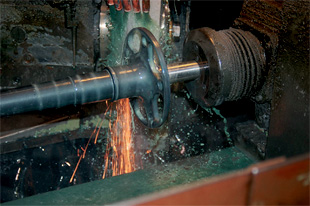Toll Free: 1-866-508-6394
OR Contact Us
OR Contact Us
Shop by Category
What Makes One Axle Better Than Another?
 The popular Hi-Torque line of axles are made from a Chromium-Nickel-Molybdenum alloy, which is then through-hardened using the Austempering process (the axle is heated in a solution then quenched in another). This makes the axle more ductile (and less brittle) than those heat-treated with conventional oil quench and draw process. For its “Ultimate” axles M-W uses 300M alloy, which has a much higher tensile strength and the forgings can be lightened more aggressively without sacrificing durability. Next is the design. If you look closely at an M-W Hi-Torque axle you’ll see that there’s a slight taper from the bearing seat down to the spline (equal to its minor diameter). This also increases the axle’s ductility, allowing it to flex and rebound like a torsion bar instead of snapping. Each axle is custom-made to order, and the spline length is such that it provides optimum engagement with the spool or differential. Some manufacturers gang run axles with long splines and merely chop the axle to the desired length. It’s also important to note that M-W puts a true involute spline on every axle it manufactures using a proprietary (patent pending) process. Because there is a slight curvature to the spline there is better engagement than with straight-cut splines like some manufacturers employ, Also, M-W uses a 45° pressure angle spline for the axle and spool —proven to be the best. Now let’s talk about manufacturing quality. Mark Williams Enterprises goes to great lengths to machine each axle to ulta-close tolerances. A finish-grinding operation assures that the bearing seat and axle flange are spot-on perpendicular. This, combined with the precisely accurate splines, provides optimum efficiency. You can actually feel that there’s less drag when rotating the rear wheel of an M-W equipped race car. Additional improvements in performance can be had by lightening the axle—which is critical unsprung weight. Operations include gun-drilling, pocket milling, and scalloping the flanges. The “Ultimate” 300M axle weighs about half of a standard model. All Hi-Torque and Ultimate axles are shot-peened and black oxide finished. As you would suspect, the extra steps that go into machining, heat-treating and finishing M-W axles do result in a product that’s more costly to manufacture. But that’s also why a Rolex watch costs more than a Timex.
|